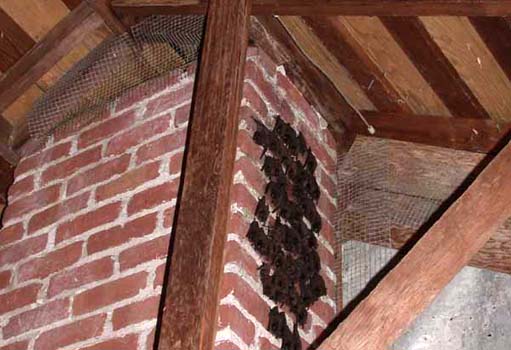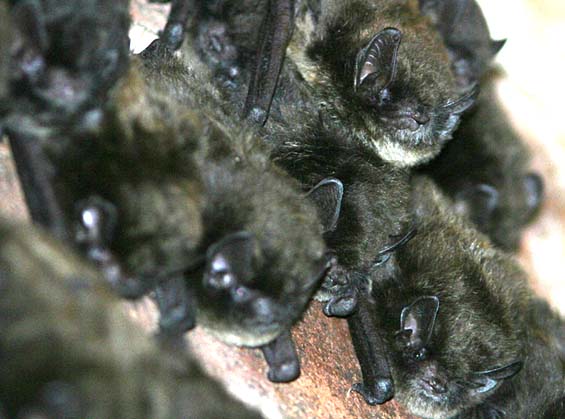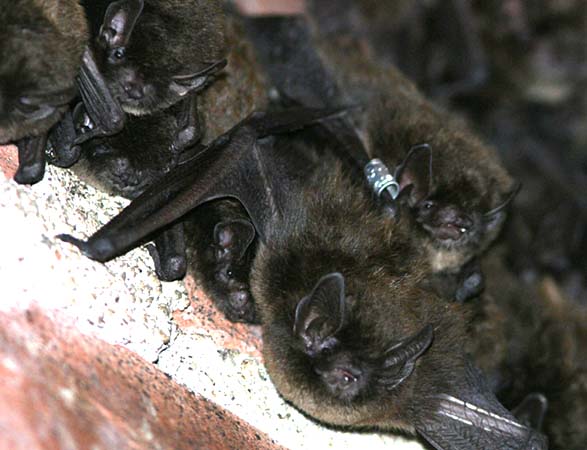| Walt Koenig is the research zoologist at Hastings
Natural History Reservation
in upper Carmel Valley, Monterey County, California. He is
internationally
known as the expert on Acorn Woodpecker. Hastings
NHR, a field research center associated with the Univ. of
California,
Berkeley, is an excellent study site. It is rolling oak savanna (above)
with a riparian stream and nearby chaparral. While chatting with Walt
recently,
we learned that he had bats in his belfry ... er, an unused garage.
Walt
sent me this photo (right); Rita and I drove the hour inland on 1 July
2006 to take a closer look at bats that use oak savanna and day-roost
in
a garage. |

|
|
 The
bat roost is impressive. They are mostly rather small bats with 'pug'
faces
but no leaf-noses, and rather short ears. They are mostly brownish
above
and paler below. Size, color, ears and face all suggest bats in the
genus Myotis.
There have been bat research projects at Hastings NHR in the past, and
the Hastings website has an excellent key
to the bats of central California. Alas, the key is best used with
bats in hand;, when one can measure various body parts. Here, we just
have
photos. Previous research as shown, however, that at least a dozen
species
of bats have been recorded at Hastings, including 4-5 species of Myotis. The
bat roost is impressive. They are mostly rather small bats with 'pug'
faces
but no leaf-noses, and rather short ears. They are mostly brownish
above
and paler below. Size, color, ears and face all suggest bats in the
genus Myotis.
There have been bat research projects at Hastings NHR in the past, and
the Hastings website has an excellent key
to the bats of central California. Alas, the key is best used with
bats in hand;, when one can measure various body parts. Here, we just
have
photos. Previous research as shown, however, that at least a dozen
species
of bats have been recorded at Hastings, including 4-5 species of Myotis. |
| Evidence of prior bat research was apparent during our
short mid-day
visit: one of the bats was banded with a metal USFWS band [left]. In
the
mass of bats on the chimney, we never did figure out exactly which bat
had the band. |
 |
|
| I focus (below) on two bats from the initial photo (above),
and have
put a yellow dot on the tragus in the right ear (left ear in our view)
of each bat. The tragus is a fleshy appendage at the entrance of the
ear
that may aid in echolocation (Inges 1965). Its size and shape is
important
in the identification of some bats. I see a quite different shape in
the
tragus of these two bats. The one on the left has a tragus that extends
almost half-way up the ear, and is curved (like half of a boomerang),
while
the right-hand bat has a shorter, triangle-shaped tragus. The ears also
look a bit shorter overall. Do these represent two species of Myotis?
Or
could the second bat (right-hand bat below) just be a youngster with
less
than full-grown ears and tragi? Does the latter theory explain the
apparently
small, blacker bats in the photo above (the one with the banded bat),
especially
those with "puppylike" faces? |
|
|
|
Dave Johnston at U.C. Berkeley provided the answer: this is a
maternity roost of Long-legged Myotis
Myotis volans, and those
with triangular shaped tragus are the youngsters.
|
|
Literature cited:
Ingles, L.G. 1965. Mammals of the Pacific States, 3d
ed. Stanford
Univ. Press, Stanford, CA.
|
| PHOTOS: All photos are © 2006 Don Roberson,
except those
attributed to other photographers and used with permission; all rights
reserved.
TOP
TO LIST OF
BIRD
FAMILIES OF THE WORLD
TO MONTEREY
COUNTY
PAGE
TO HOME
PAGE
|

